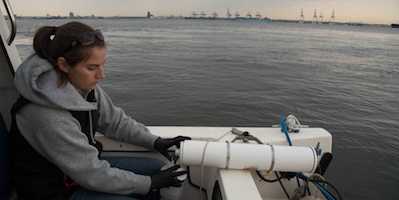2016 Recap from the Water Quality Monitoring Team
During the winter months, our Water Quality Monitoring Team’s tidal fieldwork goes on temporary hiatus. But every year from April through November, we take our boat out once per week to monitor water quality in the Baltimore Harbor, Middle Branch, and the outer portions of the Patapsco River.

By using scientific instrumentation our staff and volunteers gather water samples and record profiles of the water column at different depths to help us determine the health of our waterways. The numeric data we collect is the backbone of our water quality analyses, but we also document events that are more obvious to the naked eye such as wildlife in the water and on land. These sightings give us an even deeper understanding of the condition of our watersheds.
 Brown Pelicans flying over the Baltimore Harbor Waterkeeper Boat
Brown Pelicans flying over the Baltimore Harbor Waterkeeper Boat
Spotting wildlife is always exciting. Each season reveals different species that coexist in our waterways, and 2016 did not disappoint. In the beginning of June we started seeing small schools of cownose rays swimming in the Inner Harbor. They were spotted sporadically for a week or so and then reappeared in August and seemed to be hunting schools of fish individually. We regularly see a wide variety of seabirds such as cormorants, ospreys, and sea gulls; but this year we witnessed a few species we have not encountered in the past. For example, we saw a bald eagle on the edge of Stoney Creek and numerous brown pelicans in the Harbor near the Key Bridge. While herons and egrets fishing and wading on the shorelines are commonplace, we observed a communal rookery of great blue herons and white egrets in Cox Creek. These sightings serve as evidence that despite all of the pollution we see entering the Harbor, there are diverse groups of living creatures thriving in our waterways.
 Cownose Ray swimming near Fort Carroll.
Cownose Ray swimming near Fort Carroll.
Unfortunately, not all of the wildlife we encounter is healthy or alive. On Wednesday, September 7th the Water Quality Team set out to monitor the Patapsco main stem past the Key Bridge and witnessed a natural inversion of the water column in the Inner Harbor. A natural inversion can occur when the surface waters start to cool; often this is influenced by a drastic drop in air temperature. Since colder water is denser, it sinks to the bottom, forcing the warmer water to the surface. In this instance, the natural inversion coincided with an algae bloom that was already starting to die off naturally. Oxygen-depleting bacteria had decomposed the dying algae, effectively creating a dead zone at the bottom of the Harbor.

 Photos from the natural inversion in the Inner Harbor
Photos from the natural inversion in the Inner Harbor
Once the natural inversion occurred, the flip of the water column trapped the fish in a layer of water devoid of oxygen, causing them to suffocate and die. We observed dead white perch, ale wife, shad, pumpkin seed sunfish, and blue crabs. The water also turned a greenish milky color due to the sulfur from the bottom which is now on the surface and reacts to UV rays. In addition, the water emits a putrid sulfuric smell, similar to rotten eggs. The National Aquarium wrote a great blog about this event, you can find it here.
 Pumpkin Seed Sunfish Killed in Natural Inversion Event
Pumpkin Seed Sunfish Killed in Natural Inversion Event

Blue Crab Killed in Natural Inversion Event with Dead Fish in the Background
If you observe any of our local waterways smelling foul or the color seems unnatural, please report these events to our pollution reporting hotline by clicking here. Also, if you are interested in volunteering with the Water Quality Monitoring Team, keep an eye on our calendar for future events.
Even though our tidal program is taking a break for the winter, we are still monitoring water quality in the Jones Falls and Gwynns Falls watersheds year-round. Check out the most recent data at Harbor Alert.

